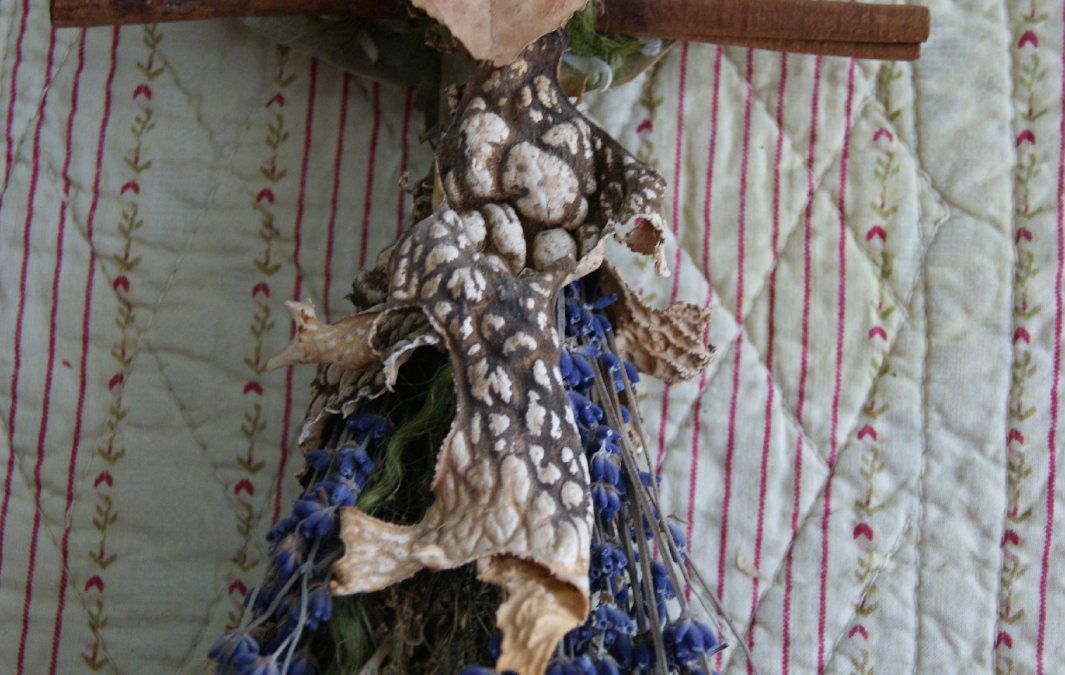Presented by Cindy Hasko and Sarah Sieradzki
(Adapted from “Good Angels from the Garden” by Theresa Loe, Herb Companion, January 2005.)
Fragrant herbal angels can be made any time of the year with either fresh or dried herbs, and other botanicals. They can represent a guardian angel, a garden fairy, or even be used as a worry doll depending on the purpose of your horticultural therapy program session.
Therapeutic aspects of this project include the use of fragrance, the sense of ownership that comes with growing and collecting your own botanicals, experiencing the healing the power of nature, relaxation, sensory stimulation, creativity, and reminiscence. To use the angel as a worry doll, have your participants write down their worries on a small piece of decorative paper, and wrap this around the angel’s body or arms as they create their angel. The doll can then carry (and thus relieve) the participants’ worries. This can be used to prompt a discussion about worry, and ways to better cope with one’s concerns.
MATERIALS:
Use what is available in your garden or in nature. This is a great project to bring nature inside. Rather than purchasing materials, take a hike in a meadow, or a tour through a garden to collect materials (with permission.) Nature walks can be done in every season of the year. This is the ultimate “green” project— reduce, recycle, reuse! Using fresh or dried herbs will add wonderful fragrances, textures, and even flavors to this project. Anything that you can press can be added at the end to decorate the bodice and wings. Plant an herb garden in the spring, and you can collect your own materials throughout the growing season. Bundle up fresh herbs, tie with a rubber band, and hang or lie flat to dry.
NOTE: Botanical materials can be used fresh or dried when creating the angels. Fresh botanicals are more flexible and easier to work with for children, elders, and individuals with limited coordination. Fresh materials will also have more fragrance, but will need to be in a dry warm place to dry when the angel is completed. Dried materials can be used during the winter months or other times when fresh botanicals are not available.
FOR HEAD AND MAIN BODY SUPPORT:
Long stemmed dried poppy pods, long stemmed large echinacea seed heads, thistles, teasels (Poppy pods and stems are available at craft stores.)
Can add larger twig to tie onto stems to add better support for body
Can add acorn caps for hats or money plant seed pods for a halo
FOR HAIR:
Spanish moss, lichen, wool roving, cotton
FOR ARMS:
6” cinnamon sticks, short twigs, bundled small twigs, bundled pine needles
FOR MAIN BODY AND SKIRT: (all in small tied bundles)
Lavender, goldenrod, amaranth, astilbe, mints, marjoram, oregano, artemesia, rosemary, lemon verbena, hydrangea heads, strawflowers (these have weak stems—insert wire into back of flower), clover, quaking sea oats, marigolds, pussy willows, arborvitae, globe amaranth, sage, statice, baby’s breath, small rosebuds, branchlets of oak leaves, Chinese lanterns, Russian sage, corn husks, eucalyptus
FOR BODICE:
Pressed leaves: ginkgo, oak, Japanese maples, purple smoke tree, red maples, yellow birch, sweet gum, sassafras, sturdy pressed flowers, acorn cap
FOR OVERSKIRT OR APRON:
Lichen, bark, pressed leaves
FOR WINGS:
Pressed leaves: Bay, Dusty Miller, arborvitae, magnolia, or milkweed pods, skeleton leaves, maple seeds
TOOLS AND ADDITIONAL SUPPLIES:
Raffia, ribbon, twine, jute, paper twine, hemp cording
Scissors or garden clippers
Small rubber bands or twist ties
Glue or low melt glue guns
Newspaper or large rolled paper to cover tables
Dust pan and whisk broom
Paper bags for taking completed projects home
INSTRUCTIONS:
- Hold the arm twig or cinnamon stick perpendicular across the poppy or echinacea stem about one inch below the angel’s head. (If you need to add support to the body, place a twig alongside the stem.) Wrap raffia or twine in a criss cross fashion to attach the arms to the main body support. Tie tightly and knot. Add a small loop for hanging the angel if desired.
- Create a small bouquet of herbs and botanicals, and secure the ends with a rubber band. Turn the bouquet upside down and secure to the body with raffia right under the arms. Add more herb sprigs if needed to evenly create a skirt. Use a hot glue gun if needed to fill in any gaps with extra botanicals.
- Place a fresh or pressed leaf over the crossing of the arms and body to create a bodice. Tie or hot glue it into place. Tie or glue on another type of botanical to create an overskirt or apron. Wrap extra raffia around the angel’s waist to further secure the skirt botanicals if desired. This will also help hold the entire angel together and give it more support.
- Hot glue two leaves or pods onto the back of the angel to create wings. Decorate with pressed flowers, skeleton leaves, or Dusty Miller leaves if desired.
- Hot glue on Spanish moss or lichen on the head to create hair. Add an acorn cap for a hat, or a money plant pod to create a halo.
- If fresh botanicals were used, carefully hang the angel in a warm dry place where it can dry slowly so it keep its shape, colors, and fragrance.

